Hyundai Terracan 2004 Owner's Manual
Manufacturer: HYUNDAI, Model Year: 2004, Model line: Terracan, Model: Hyundai Terracan 2004Pages: 361, PDF Size: 4.69 MB
Page 141 of 361
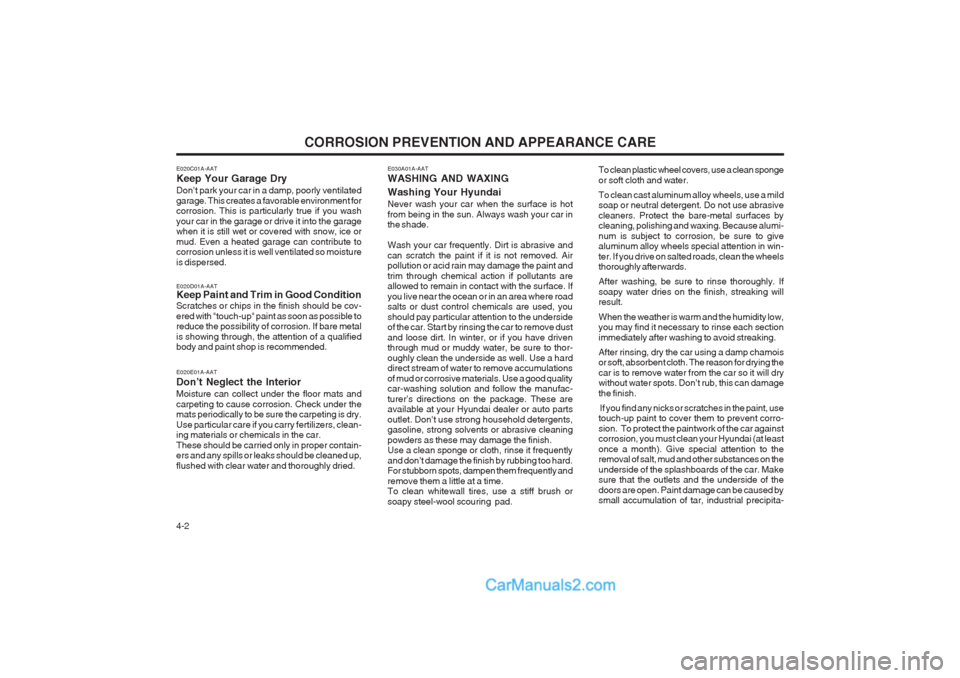
CORROSION PREVENTION AND APPEARANCE CARE
4-2
E020C01A-AAT Keep Your Garage Dry Don’t park your car in a damp, poorly ventilated garage. This creates a favorable environment for corrosion. This is particularly true if you wash your car in the garage or drive it into the garage when it is still wet or covered with snow, ice or mud. Even a heated garage can contribute to corrosion unless it is well ventilated so moisture is dispersed. E020D01A-AAT Keep Paint and Trim in Good Condition Scratches or chips in the finish should be cov- ered with "touch-up" paint as soon as possible to reduce the possibility of corrosion. If bare metal is showing through, the attention of a qualified body and paint shop is recommended. E020E01A-AAT Don’t Neglect the Interior Moisture can collect under the floor mats and carpeting to cause corrosion. Check under the mats periodically to be sure the carpeting is dry. Use particular care if you carry fertilizers, clean- ing materials or chemicals in the car. These should be carried only in proper contain- ers and any spills or leaks should be cleaned up, flushed with clear water and thoroughly dried.
E030A01A-AAT WASHING AND WAXING Washing Your Hyundai Never wash your car when the surface is hot from being in the sun. Always wash your car in the shade. Wash your car frequently. Dirt is abrasive and can scratch the paint if it is not removed. Air pollution or acid rain may damage the paint and trim through chemical action if pollutants are allowed to remain in contact with the surface. If you live near the ocean or in an area where road salts or dust control chemicals are used, you should pay particular attention to the underside of the car. Start by rinsing the car to remove dust and loose dirt. In winter, or if you have driven through mud or muddy water, be sure to thor- oughly clean the underside as well. Use a hard direct stream of water to remove accumulations of mud or corrosive materials. Use a good quality car-washing solution and follow the manufac- turer’s directions on the package. These are available at your Hyundai dealer or auto parts outlet. Don’t use strong household detergents, gasoline, strong solvents or abrasive cleaning powders as these may damage the finish. Use a clean sponge or cloth, rinse it frequently and don’t damage the finish by rubbing too hard. For stubborn spots, dampen them frequently and remove them a little at a time. To clean whitewall tires, use a stiff brush or soapy steel-wool scouring pad.To clean plastic wheel covers, use a clean spongeor soft cloth and water. To clean cast aluminum alloy wheels, use a mild soap or neutral detergent. Do not use abrasive cleaners. Protect the bare-metal surfaces by cleaning, polishing and waxing. Because alumi- num is subject to corrosion, be sure to give aluminum alloy wheels special attention in win- ter. If you drive on salted roads, clean the wheels thoroughly afterwards. After washing, be sure to rinse thoroughly. If soapy water dries on the finish, streaking will result. When the weather is warm and the humidity low, you may find it necessary to rinse each section immediately after washing to avoid streaking. After rinsing, dry the car using a damp chamois or soft, absorbent cloth. The reason for drying the car is to remove water from the car so it will dry without water spots. Don’t rub, this can damage the finish. If you find any nicks or scratches in the paint, use touch-up paint to cover them to prevent corro- sion. To protect the paintwork of the car against corrosion, you must clean your Hyundai (at least once a month). Give special attention to the removal of salt, mud and other substances on the underside of the splashboards of the car. Make sure that the outlets and the underside of the doors are open. Paint damage can be caused by small accumulation of tar, industrial precipita-
Page 142 of 361
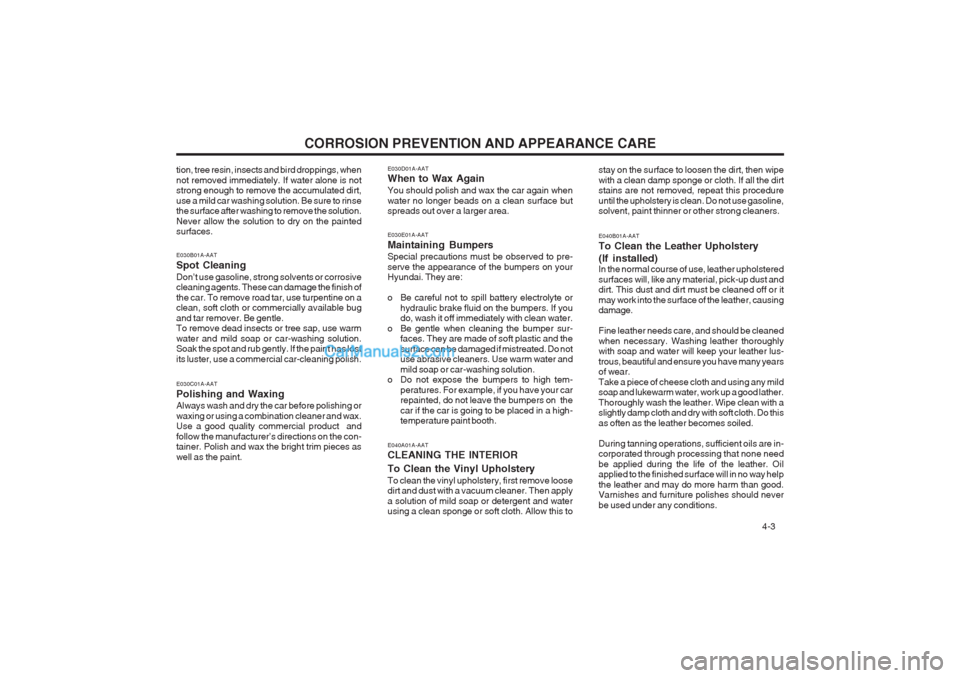
CORROSION PREVENTION AND APPEARANCE CARE 4-3
tion, tree resin, insects and bird droppings, when not removed immediately. If water alone is not strong enough to remove the accumulated dirt, use a mild car washing solution. Be sure to rinse the surface after washing to remove the solution. Never allow the solution to dry on the painted surfaces.
E030D01A-AAT When to Wax Again You should polish and wax the car again when water no longer beads on a clean surface but spreads out over a larger area. E030E01A-AAT Maintaining Bumpers Special precautions must be observed to pre- serve the appearance of the bumpers on your Hyundai. They are:
o Be careful not to spill battery electrolyte or
hydraulic brake fluid on the bumpers. If you do, wash it off immediately with clean water.
o Be gentle when cleaning the bumper sur- faces. They are made of soft plastic and the surface can be damaged if mistreated. Do not use abrasive cleaners. Use warm water and mild soap or car-washing solution.
o Do not expose the bumpers to high tem-
peratures. For example, if you have your car repainted, do not leave the bumpers on the car if the car is going to be placed in a high- temperature paint booth.
E040A01A-AAT CLEANING THE INTERIOR To Clean the Vinyl Upholstery To clean the vinyl upholstery, first remove loose dirt and dust with a vacuum cleaner. Then apply a solution of mild soap or detergent and water using a clean sponge or soft cloth. Allow this to stay on the surface to loosen the dirt, then wipe with a clean damp sponge or cloth. If all the dirt stains are not removed, repeat this procedure until the upholstery is clean. Do not use gasoline, solvent, paint thinner or other strong cleaners.
E030B01A-AAT Spot CleaningDon’t use gasoline, strong solvents or corrosive cleaning agents. These can damage the finish of the car. To remove road tar, use turpentine on a clean, soft cloth or commercially available bug and tar remover. Be gentle. To remove dead insects or tree sap, use warm water and mild soap or car-washing solution. Soak the spot and rub gently. If the paint has lost its luster, use a commercial car-cleaning polish. E030C01A-AAT Polishing and Waxing Always wash and dry the car before polishing or waxing or using a combination cleaner and wax. Use a good quality commercial product and follow the manufacturer’s directions on the con- tainer. Polish and wax the bright trim pieces as well as the paint. E040B01A-AAT To Clean the Leather Upholstery (If installed) In the normal course of use, leather upholsteredsurfaces will, like any material, pick-up dust and dirt. This dust and dirt must be cleaned off or it may work into the surface of the leather, causing damage. Fine leather needs care, and should be cleaned when necessary. Washing leather thoroughly with soap and water will keep your leather lus- trous, beautiful and ensure you have many years of wear. Take a piece of cheese cloth and using any mild soap and lukewarm water, work up a good lather. Thoroughly wash the leather. Wipe clean with a slightly damp cloth and dry with soft cloth. Do this as often as the leather becomes soiled. During tanning operations, sufficient oils are in- corporated through processing that none need be applied during the life of the leather. Oil applied to the finished surface will in no way help the leather and may do more harm than good. Varnishes and furniture polishes should never be used under any conditions.
Page 143 of 361
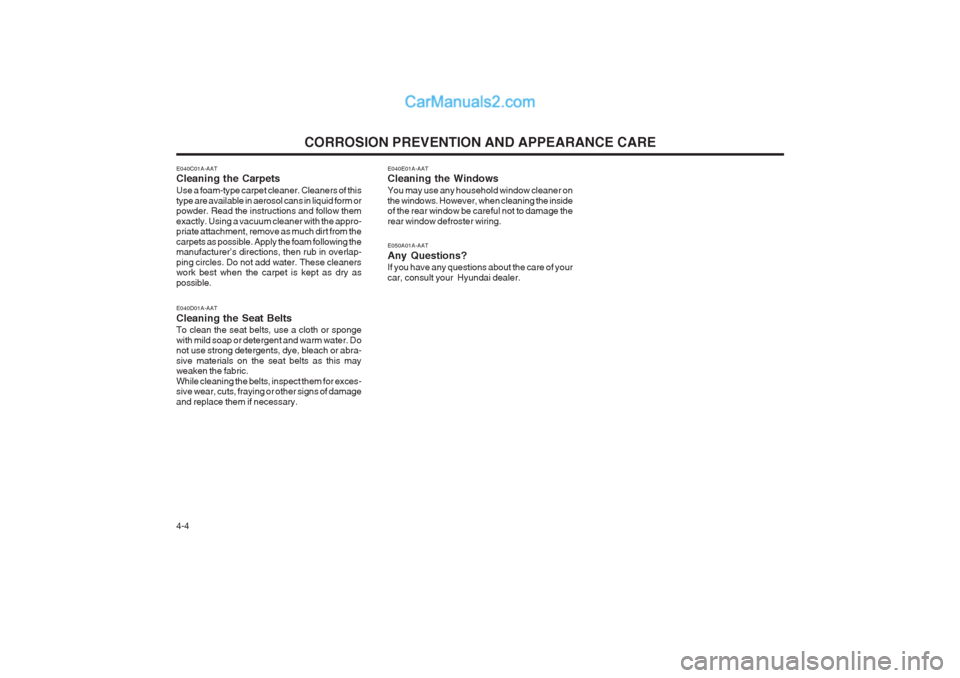
CORROSION PREVENTION AND APPEARANCE CARE
4-4 E040E01A-AAT Cleaning the Windows You may use any household window cleaner on the windows. However, when cleaning the inside of the rear window be careful not to damage the rear window defroster wiring. E050A01A-AAT Any Questions? If you have any questions about the care of your car, consult your Hyundai dealer.
E040D01A-AAT Cleaning the Seat Belts To clean the seat belts, use a cloth or sponge with mild soap or detergent and warm water. Do not use strong detergents, dye, bleach or abra- sive materials on the seat belts as this may weaken the fabric. While cleaning the belts, inspect them for exces- sive wear, cuts, fraying or other signs of damage and replace them if necessary.
E040C01A-AAT Cleaning the Carpets Use a foam-type carpet cleaner. Cleaners of this type are available in aerosol cans in liquid form or powder. Read the instructions and follow them exactly. Using a vacuum cleaner with the appro- priate attachment, remove as much dirt from the carpets as possible. Apply the foam following the manufacturer’s directions, then rub in overlap- ping circles. Do not add water. These cleaners work best when the carpet is kept as dry as possible.
Page 144 of 361
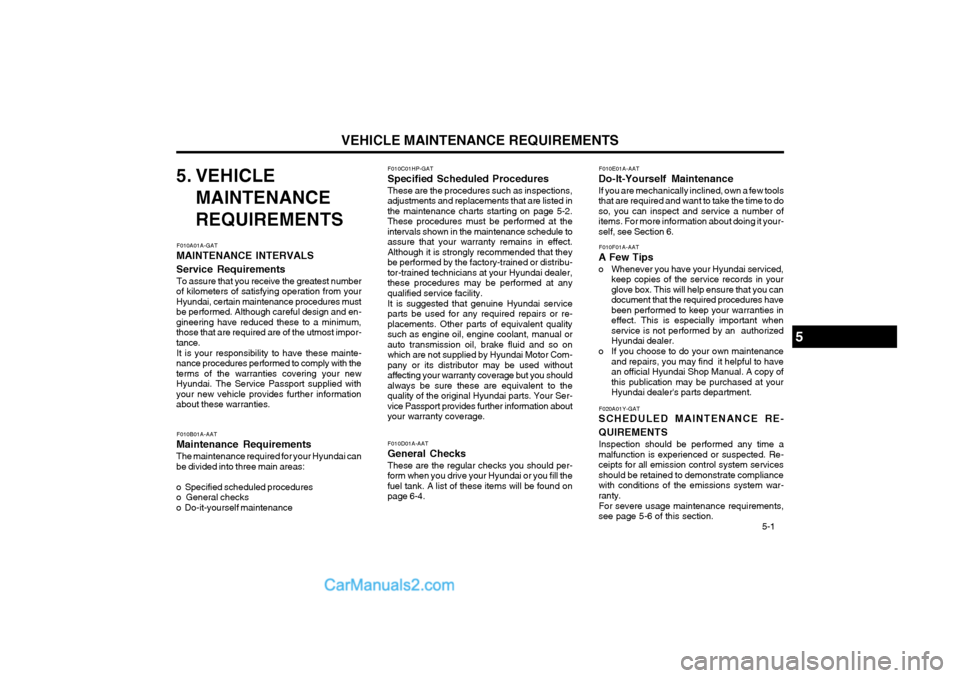
VEHICLE MAINTENANCE REQUIREMENTS 5-1
F010C01HP-GAT
Specified Scheduled Procedures
These are the procedures such as inspections,
adjustments and replacements that are listed in the maintenance charts starting on page 5-2.These procedures must be performed at theintervals shown in the maintenance schedule toassure that your warranty remains in effect.Although it is strongly recommended that theybe performed by the factory-trained or distribu-tor-trained technicians at your Hyundai dealer,these procedures may be performed at anyqualified service facility.
It is suggested that genuine Hyundai service
parts be used for any required repairs or re-placements. Other parts of equivalent qualitysuch as engine oil, engine coolant, manual orauto transmission oil, brake fluid and so onwhich are not supplied by Hyundai Motor Com-pany or its distributor may be used withoutaffecting your warranty coverage but you shouldalways be sure these are equivalent to thequality of the original Hyundai parts. Your Ser-vice Passport provides further information aboutyour warranty coverage.
5. VEHICLE
MAINTENANCE REQUIREMENTS F010E01A-AAT
Do-It-Yourself Maintenance If you are mechanically inclined, own a few tools that are required and want to take the time to doso, you can inspect and service a number ofitems. For more information about doing it your-self, see Section 6.
F010D01A-AAT
General Checks These are the regular checks you should per-
form when you drive your Hyundai or you fill thefuel tank. A list of these items will be found onpage 6-4.
F010A01A-GAT
MAINTENANCE INTERVALS Service Requirements
To assure that you receive the greatest number
of kilometers of satisfying operation from your Hyundai, certain maintenance procedures mustbe performed. Although careful design and en-gineering have reduced these to a minimum,those that are required are of the utmost impor-tance.
It is your responsibility to have these mainte-
nance procedures performed to comply with theterms of the warranties covering your newHyundai. The Service Passport supplied withyour new vehicle provides further informationabout these warranties.
F010B01A-AAT
Maintenance Requirements The maintenance required for your Hyundai can be divided into three main areas: o Specified scheduled procedures o General checkso Do-it-yourself maintenance F010F01A-AAT
A Few Tips
o Whenever you have your Hyundai serviced, keep copies of the service records in your glove box. This will help ensure that you candocument that the required procedures havebeen performed to keep your warranties ineffect. This is especially important whenservice is not performed by an authorizedHyundai dealer.
o If you choose to do your own maintenance and repairs, you may find it helpful to havean official Hyundai Shop Manual. A copy ofthis publication may be purchased at yourHyundai dealer's parts department.
F020A01Y-GAT
SCHEDULED MAINTENANCE RE- QUIREMENTS
Inspection should be performed any time a
malfunction is experienced or suspected. Re- ceipts for all emission control system servicesshould be retained to demonstrate compliancewith conditions of the emissions system war-ranty.
For severe usage maintenance requirements,
see page 5-6 of this section.
5
Page 145 of 361
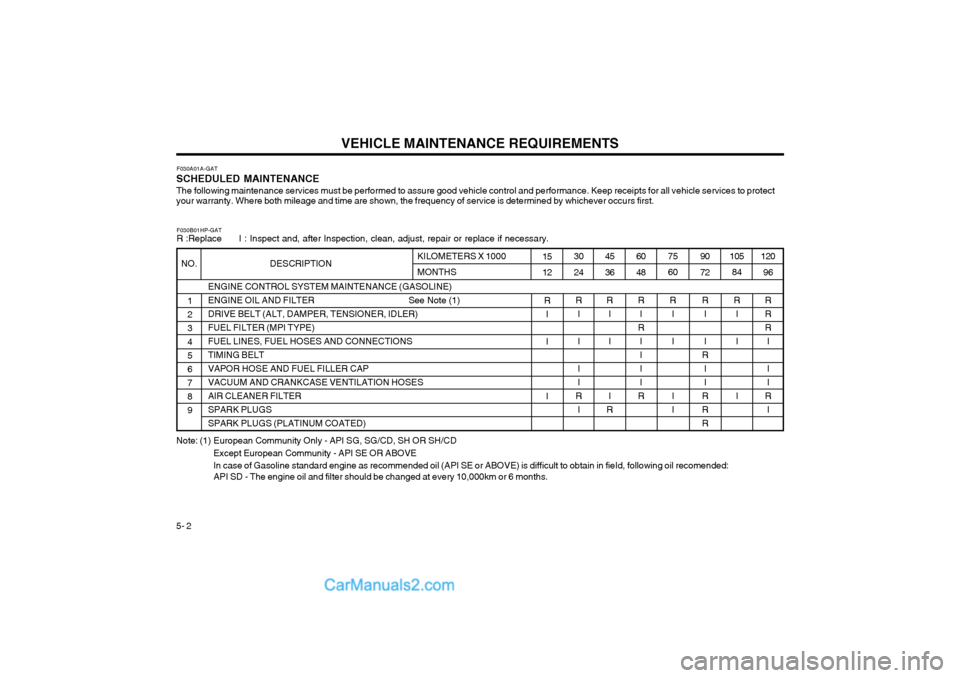
VEHICLE MAINTENANCE REQUIREMENTS
5- 2 F030A01A-GAT
SCHEDULED MAINTENANCE The following maintenance services must be performed to assure good vehicle control and performance. Keep receipts for all vehi cle services to protect
your warranty. Where both mileage and time are shown, the frequency of service is determined by whichever occurs first.
F030B01HP-GAT R :Replace I : Inspect and, after Inspection, clean, adjust, repair or replace if necessary.
ENGINE CONTROL SYSTEM MAINTENANCE (GASOLINE)
ENGINE OIL AND FILTER See Note (1)DRIVE BELT (ALT, DAMPER, TENSIONER, IDLER)FUEL FILTER (MPI TYPE)FUEL LINES, FUEL HOSES AND CONNECTIONSTIMING BELTVAPOR HOSE AND FUEL FILLER CAPVACUUM AND CRANKCASE VENTILATION HOSESAIR CLEANER FILTERSPARK PLUGSSPARK PLUGS (PLATINUM COATED)
NO. DESCRIPTION
1 2 3 4 5 6 7 8 9 120
96
RRR I I I
R I105
84
R I I I90 72
R I I
R I I
RRR75 60
R I I I I60 48
R I
R I III
R45 36
R I I I
R30 24
R I II I
R I
15 12
R I I IKILOMETERS X 1000 MONTHS
Note: (1) European Community Only - API SG, SG/CD, SH OR SH/CD Except European Community - API SE OR ABOVE
In case of Gasoline standard engine as recommended oil (API SE or ABOVE) is difficult to obtain in fieId, following oil recomen ded:
API SD - The engine oil and filter should be changed at every 10,000km or 6 months.
Page 146 of 361
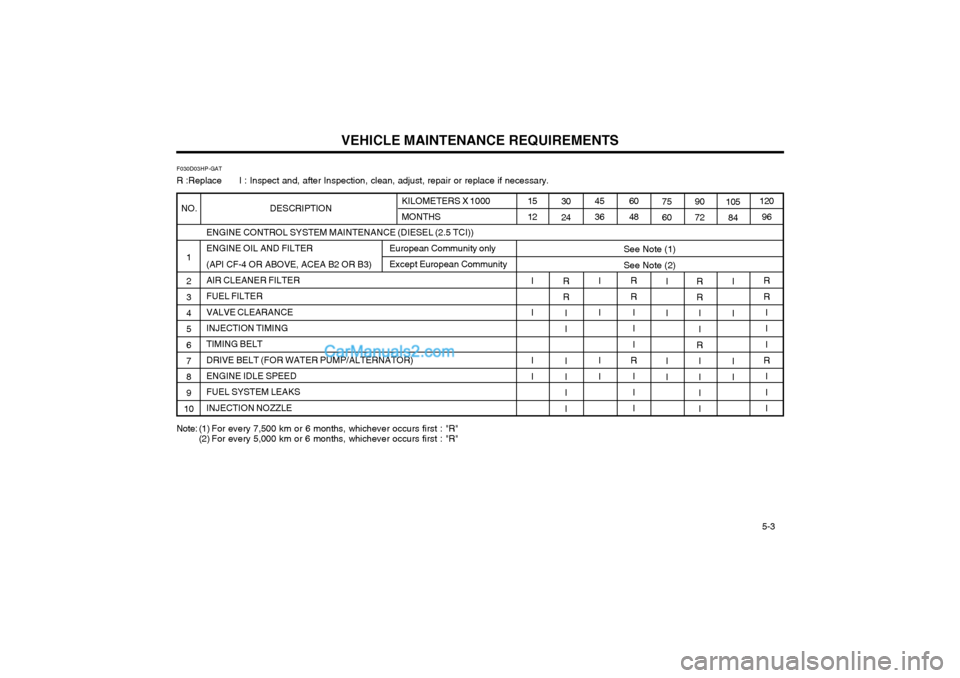
VEHICLE MAINTENANCE REQUIREMENTS 5-3
KILOMETERS X 1000 MONTHS
F030D03HP-GAT R :Replace I : Inspect and, after Inspection, clean, adjust, repair or replace if necessary.
ENGINE CONTROL SYSTEM MAINTENANCE (DIESEL (2.5 TCI)) ENGINE OIL AND FILTER(API CF-4 OR ABOVE, ACEA B2 OR B3) AIR CLEANER FILTER FUEL FILTERVALVE CLEARANCE INJECTION TIMING TIMING BELTDRIVE BELT (FOR WATER PUMP/ALTERNATOR) ENGINE IDLE SPEED FUEL SYSTEM LEAKSINJECTION NOZZLE
NO. DESCRIPTION
1 2 34 5 67 8 9
10120 96
R R I I I
R III105 84
I I I I90 72R R II
R
II I I75 60
I I I I60 48RR I I I
R III45 36
I I I I30 24R R I I I I I I15 12
I I I I
See Note (1) See Note (2)
Note: (1) For every 7,500 km or 6 months, whichever occurs first : "R" (2) For every 5,000 km or 6 months, whichever occurs first : "R"European Community only Except European Community
Page 147 of 361
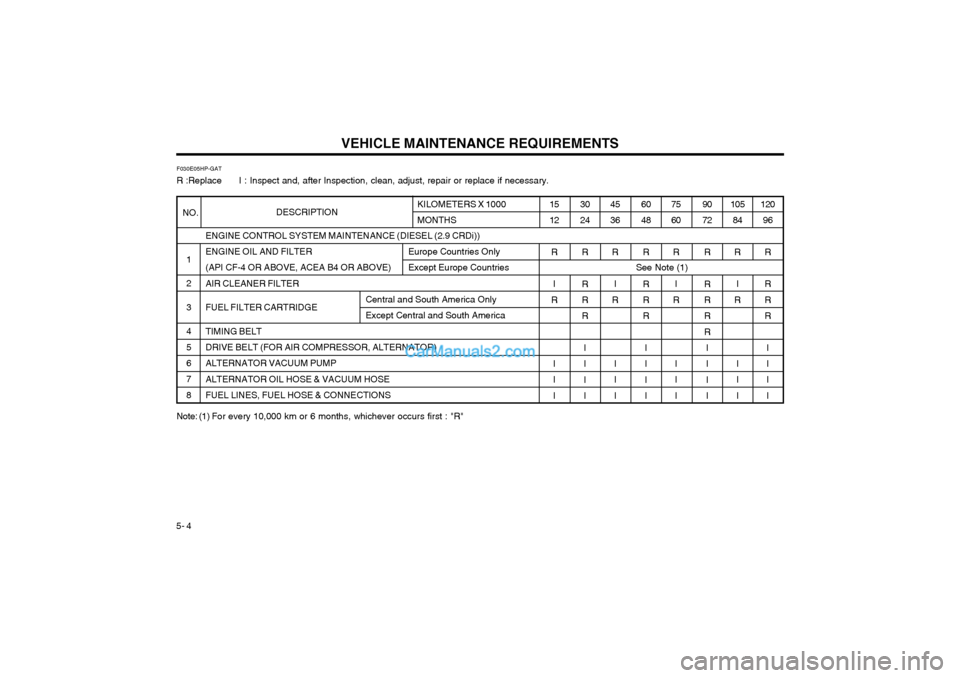
VEHICLE MAINTENANCE REQUIREMENTS
5- 4
F030E05HP-GAT R :Replace I : Inspect and, after Inspection, clean, adjust, repair or replace if necessary.
ENGINE CONTROL SYSTEM MAINTENANCE (DIESEL (2.9 CRDi)) ENGINE OIL AND FILTER (API CF-4 OR ABOVE, ACEA B4 OR ABOVE)AIR CLEANER FILTER FUEL FILTER CARTRIDGETIMING BELT DRIVE BELT (FOR AIR COMPRESSOR, ALTERNATOR) ALTERNATOR VACUUM PUMPALTERNATOR OIL HOSE & VACUUM HOSE FUEL LINES, FUEL HOSE & CONNECTIONS
1 234 56 7 8 120
96
R R RR II I I
105
84
R I
R
I I I
90 72
R R R R R III I
7560
R I
R
I II
60 48
R R R R I II I
45 36
R I
R
I I I
30 24
R R R R I II I
15 12
R I
R
I I I
KILOMETERS X 1000 MONTHS
DESCRIPTION
NO.
Europe Countries Only Except Europe Countries
See Note (1)
Note: (1) For every 10,000 km or 6 months, whichever occurs first : "R"
Central and South America Only Except Central and South America
Page 148 of 361
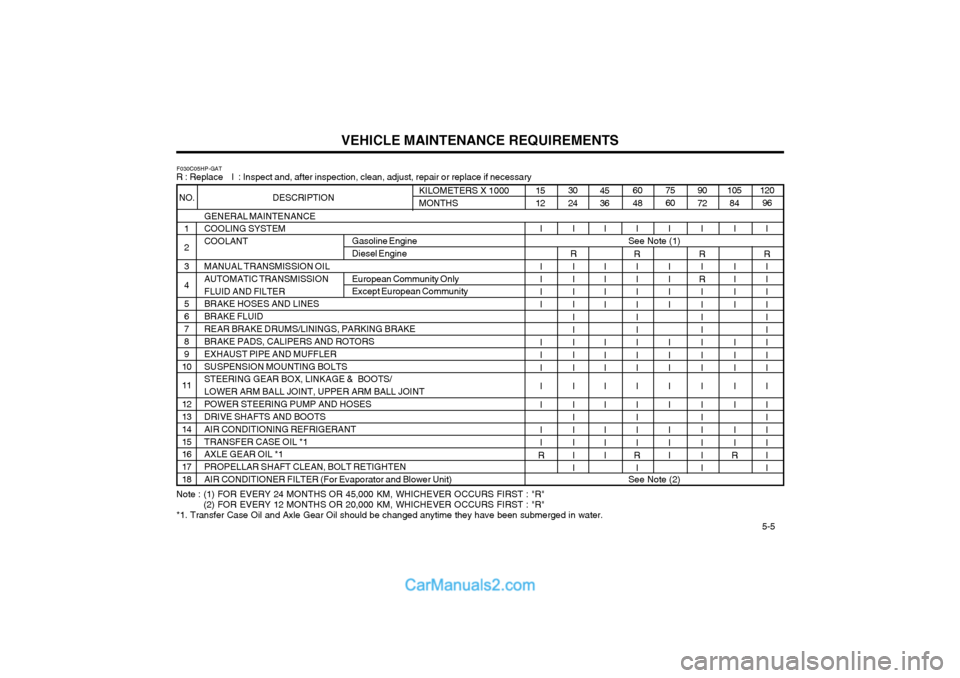
VEHICLE MAINTENANCE REQUIREMENTS 5-5
I
R I I I I I I I I I II I I I
R
I
GENERAL MAINTENANCE COOLING SYSTEM COOLANT MANUAL TRANSMISSION OIL AUTOMATIC TRANSMISSIONFLUID AND FILTER BRAKE HOSES AND LINES BRAKE FLUIDREAR BRAKE DRUMS/LININGS, PARKING BRAKE BRAKE PADS, CALIPERS AND ROTORS EXHAUST PIPE AND MUFFLERSUSPENSION MOUNTING BOLTS STEERING GEAR BOX, LINKAGE & BOOTS/ LOWER ARM BALL JOINT, UPPER ARM BALL JOINTPOWER STEERING PUMP AND HOSES DRIVE SHAFTS AND BOOTS AIR CONDITIONING REFRIGERANTTRANSFER CASE OIL *1 AXLE GEAR OIL *1 PROPELLAR SHAFT CLEAN, BOLT RETIGHTENAIR CONDITIONER FILTER (For Evaporator and Blower Unit)
1 2 3 4 5 67 8 9
10 11 12 13 1415 16 1718
F030C05HP-GAT
R : Replace I : Inspect and, after inspection, clean, adjust, repair or replace if necessary
Note : (1) FOR EVERY 24 MONTHS OR 45,000 KM, WHICHEVER OCCURS FIRST : "R"
(2) FOR EVERY 12 MONTHS OR 20,000 KM, WHICHEVER OCCURS FIRST : "R"
*1. Transfer Case Oil and Axle Gear Oil should be changed anytime they have been submerged in water.
NO. DESCRIPTION
I
R I I I I I I I I I II I I I I I15 12 30 24
45 36 60 4875 60
90 72105
84 120
96KILOMETERS X 1000 MONTHS
I
R I I I I I I I I I II I I I I I I I I I I I I I II I I I
I I I I I I I I II I I
R I I I I I I I I II I I II
R I
R I I I I I I I II I I I I I I I I I I I I I II I I
R
European Community Only Except European Community
See Note (1)Gasoline Engine Diesel Engine
See Note (2)
Page 149 of 361
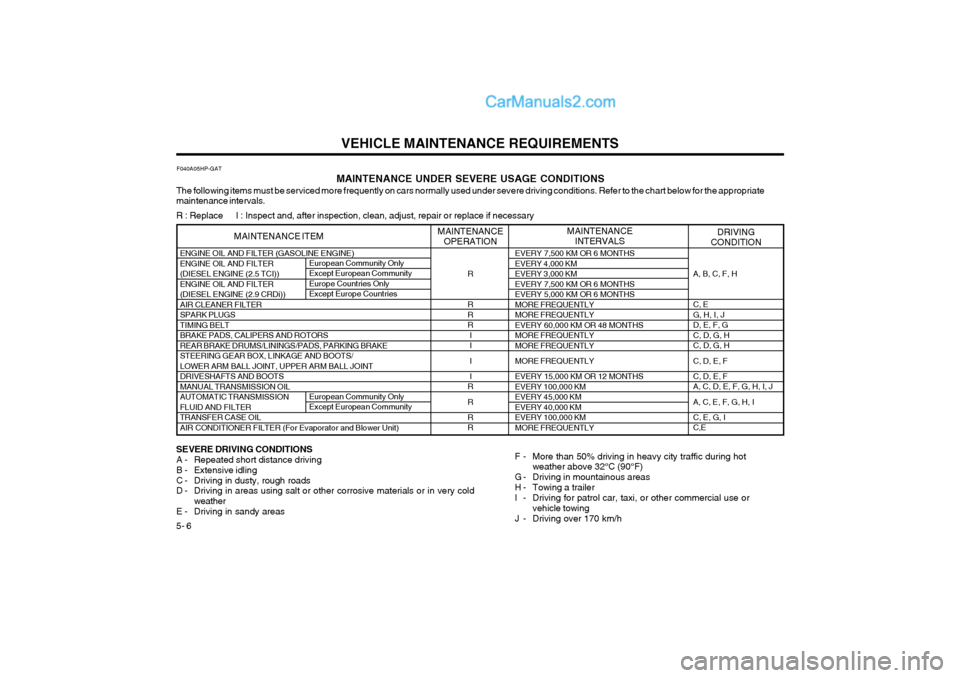
VEHICLE MAINTENANCE REQUIREMENTS
5- 6 ENGINE OIL AND FILTER (GASOLINE ENGINE) ENGINE OIL AND FILTER(DIESEL ENGINE (2.5 TCI))ENGINE OIL AND FILTER
(DIESEL ENGINE (2.9 CRDi))AIR CLEANER FILTERSPARK PLUGSTIMING BELTBRAKE PADS, CALIPERS AND ROTORSREAR BRAKE DRUMS/LININGS/PADS, PARKING BRAKESTEERING GEAR BOX, LINKAGE AND BOOTS/LOWER ARM BALL JOINT, UPPER ARM BALL JOINTDRIVESHAFTS AND BOOTSMANUAL TRANSMISSION OILAUTOMATIC TRANSMISSIONFLUID AND FILTERTRANSFER CASE OILAIR CONDITIONER FILTER (For Evaporator and Blower Unit)
R R RR
II I I
R R R R
European Community OnlyExcept European CommunityEurope Countries OnlyExcept Europe Countries
A, B, C, F, H C, E G, H, I, JD, E, F, GC, D, G, HC, D, G, H C, D, E, F C, D, E, F A, C, D, E, F, G, H, I, J A, C, E, F, G, H, I C, E, G, I C,E
F040A05HP-GAT
MAINTENANCE UNDER SEVERE USAGE CONDITIONS
The following items must be serviced more frequently on cars normally used under severe driving conditions. Refer to the chart below for the appropriate maintenance intervals. R : Replace I : Inspect and, after inspection, clean, adjust, repair or replace if necessary SEVERE DRIVING CONDITIONS
A - Repeated short distance driving
B - Extensive idling
C - Driving in dusty, rough roads
D - Driving in areas using salt or other corrosive materials or in very cold weather
E - Driving in sandy areas F - More than 50% driving in heavy city traffic during hot
weather above 32°C (90°F)
G - Driving in mountainous areas
H - Towing a trailer
I - Driving for patrol car, taxi, or other commercial use or
vehicle towing
J - Driving over 170 km/h
MAINTENANCE ITEM
European Community Only Except European Community
DRIVING
CONDITION
MAINTENANCE
OPERATION MAINTENANCE
INTERVALS
EVERY 7,500 KM OR 6 MONTHS EVERY 4,000 KMEVERY 3,000 KMEVERY 7,500 KM OR 6 MONTHSEVERY 5,000 KM OR 6 MONTHSMORE FREQUENTLYMORE FREQUENTLYEVERY 60,000 KM OR 48 MONTHSMORE FREQUENTLYMORE FREQUENTLY MORE FREQUENTLY EVERY 15,000 KM OR 12 MONTHS EVERY 100,000 KMEVERY 45,000 KMEVERY 40,000 KMEVERY 100,000 KMMORE FREQUENTLY
Page 150 of 361
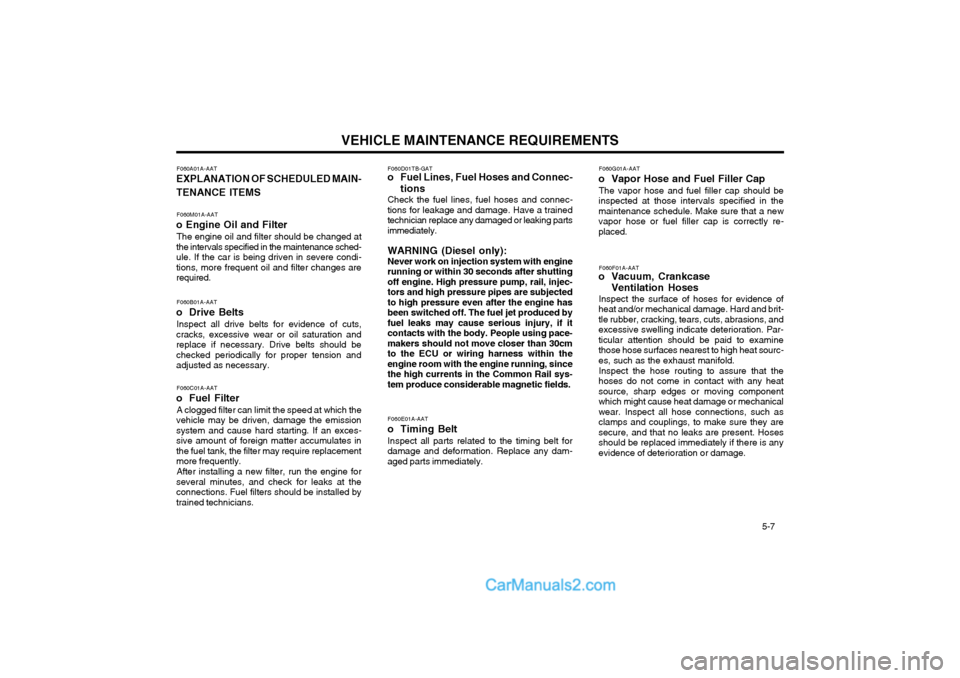
VEHICLE MAINTENANCE REQUIREMENTS 5-7
F060A01A-AAT
EXPLANATION OF SCHEDULED MAIN- TENANCE ITEMS
F060M01A-AAT
o Engine Oil and Filter The engine oil and filter should be changed at
the intervals specified in the maintenance sched- ule. If the car is being driven in severe condi-tions, more frequent oil and filter changes arerequired.
F060B01A-AAT
o Drive Belts Inspect all drive belts for evidence of cuts,
cracks, excessive wear or oil saturation andreplace if necessary. Drive belts should bechecked periodically for proper tension andadjusted as necessary.
F060C01A-AAT
o Fuel Filter
A clogged filter can limit the speed at which the
vehicle may be driven, damage the emissionsystem and cause hard starting. If an exces-sive amount of foreign matter accumulates inthe fuel tank, the filter may require replacementmore frequently.
After installing a new filter, run the engine for
several minutes, and check for leaks at theconnections. Fuel filters should be installed bytrained technicians. F060D01TB-GAT
o Fuel Lines, Fuel Hoses and Connec-
tions
Check the fuel lines, fuel hoses and connec-
tions for leakage and damage. Have a trainedtechnician replace any damaged or leaking partsimmediately. WARNING (Diesel only): Never work on injection system with engine
running or within 30 seconds after shutting off engine. High pressure pump, rail, injec-tors and high pressure pipes are subjectedto high pressure even after the engine hasbeen switched off. The fuel jet produced byfuel leaks may cause serious injury, if itcontacts with the body. People using pace-makers should not move closer than 30cmto the ECU or wiring harness within theengine room with the engine running, sincethe high currents in the Common Rail sys-tem produce considerable magnetic fields.
F060E01A-AAT
o Timing Belt Inspect all parts related to the timing belt for
damage and deformation. Replace any dam-aged parts immediately. F060G01A-AAT
o Vapor Hose and Fuel Filler Cap
The vapor hose and fuel filler cap should be
inspected at those intervals specified in themaintenance schedule. Make sure that a newvapor hose or fuel filler cap is correctly re-placed.
F060F01A-AAT
o Vacuum, Crankcase
Ventilation Hoses
Inspect the surface of hoses for evidence of
heat and/or mechanical damage. Hard and brit-tle rubber, cracking, tears, cuts, abrasions, andexcessive swelling indicate deterioration. Par-ticular attention should be paid to examinethose hose surfaces nearest to high heat sourc-es, such as the exhaust manifold.
Inspect the hose routing to assure that the
hoses do not come in contact with any heatsource, sharp edges or moving componentwhich might cause heat damage or mechanicalwear. Inspect all hose connections, such asclamps and couplings, to make sure they aresecure, and that no leaks are present. Hosesshould be replaced immediately if there is anyevidence of deterioration or damage.